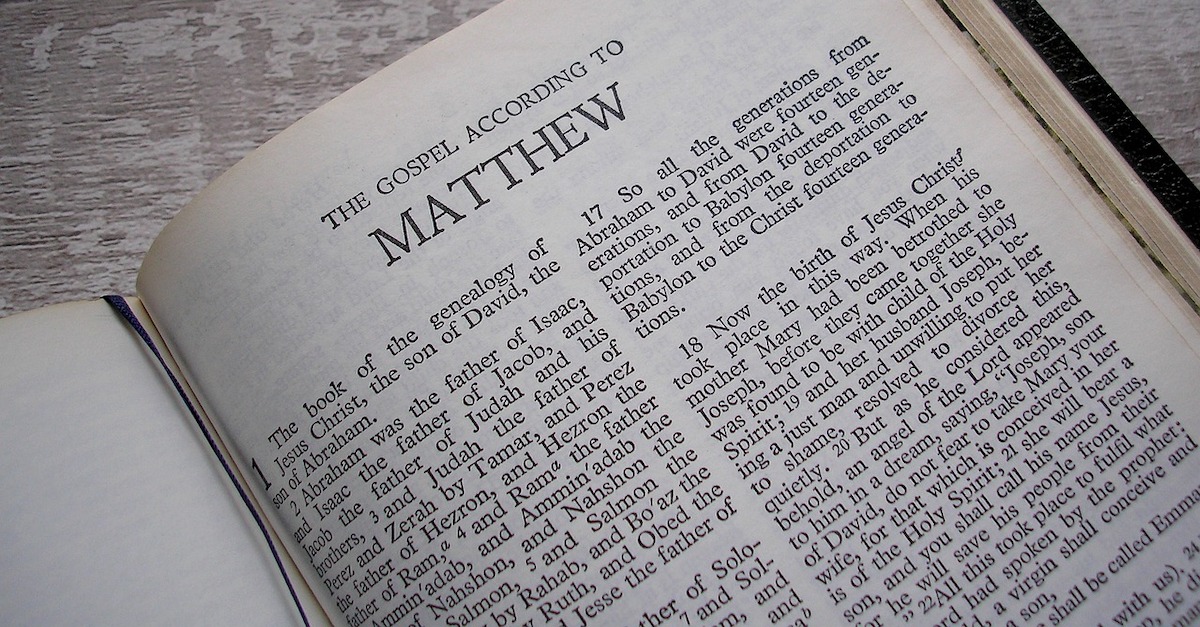
The Bible is no stranger to genealogies and family trees. Unfortunately, when it comes to most biblical genealogies, readers today tend to skim through or gloss over these chapters entirely. Maybe it’s because long lists of hard-to-pronounce names aren’t exactly page-turners. To some, they are outright boring. However, there is a lot more to gain from the study of biblical genealogies than we often realize. Genealogies are included in the Bible for a reason, and no genealogy is more important and worthy of our attention than the family tree of Jesus Christ.
Photo credit: Unsplash/Jeremy Bishop
What Does the Bible Tell Us about Jesus' Family Tree?
The New Testament includes two records of Jesus’ family tree in Matthew 1:1-17 and Luke 3:23-38. However, neither list was written to be comprehensive or exhaustive. Instead, both Matthew and Luke included names and details that affirm and, through genealogical evidence, attempt to confirm that Jesus Christ was and is the promised, prophesied Messiah. Matthew, for example, begins his Gospel (and the New Testament) with the proclamation that Jesus of Nazareth is the Messiah written about in the Old Testament. How does he do this?
To start, Matthew makes an essential connection of Jesus as a descendent of both David and Abraham (Matthew 1:1). As any Jewish scholar knows, any claim of Jesus’ Messianic identity must begin by establishing this relationship. Not only was Abraham promised a family, through whom all the nations of the world would be blessed (Genesis 12:2-3, 22:18), God made clear that the true king of Israel, the one who would sit on His eternal throne, would also be an heir of King David (2 Samuel 7:12; Psalms 89:3-4; Psalms 132:11).
Matthew makes both of these connections, arguing to his Jewish readers that the Jesus they had heard about was in fact the Messiah they had been promised. He makes the claim, verifies his claim through genealogical evidence, then goes on to expand on it through his Gospel. Luke, on the other hand, waits until chapter three of his Gospel to detail the family history of Jesus and does so after Jesus’ baptism and public ministry has begun (Luke 3:23-38). Luke also notes Jesus’ connection to David and Abraham, but unlike Matthew, traces Jesus’ family tree all the way back to Adam, the first man and original “son of God” (Luke 3:38).
Writing to a primarily Greek audience, as opposed to Matthew’s mostly Jewish readership, Luke focused on the humanity of Jesus and His role as a savior for all. In this way, Luke affirms Christ’s role as the “last Adam” (1 Corinthians 15:45) in whom all the nations of the world are blessed (Genesis 22:18; Genesis 18:18; Galatians 3:7-9) and all things are made new (2 Corinthians 5:17). In Adam, the original son of God, we inherited the curse of sin; in Jesus, the literal Son of God, we inherit the promise of forgiveness, salvation, and eternal life.
According to Matthew Henry, tracing Jesus’ genealogy all the way back to Adam was designed to show, “that Christ was the seed of the woman, that should break the serpent’s head” (Genesis 3:15). Both genealogies establish these essential attributes of Jesus Christ as the Messiah, Savior, and Son of God. And though many readers quickly move past biblical genealogies, there are several key aspects of Jesus’ family tree worth knowing.
Here are seven things to know about Jesus' family tree:
How Precise Were Scholars about Jesus' Famiily Tree?

1. Scholars Were Very Precise
At the time they were written, the genealogies of Matthew and Luke would have been treated as credible, legal documents chronicling the family history of Jesus of Nazareth. In fact, the names listed in both genealogies could have been fact-checked and verified through public records kept in the Jewish temple. In this way, the genealogies of Jesus help support the historical accuracy and reliability of the Gospels. This is important because the veracity of Jewish record keeping provided accountability and support for Matthew and Luke’s claims.
The Gospel writers weren’t just making things up or forcing familial connections to try and make Jesus out to be someone He wasn’t. If so, their genealogical claims could have been challenged and disproven rather easily. Both men, instead, had done their research, and because Jewish scribes had been so precise in their record-keeping prior to the Gospels, the genealogies of Jesus had both legal and historical backing that made them harder to refute.
2. God Uses Broken People for His Glory
No family is perfect, and most people aren’t very keen to share about the misdeeds and mistakes of their ancestors. This was certainly the case in ancient times. In most instances, even today, we tend to focus on the good parts of our history and may even leave out the bad, rotten apples of our family tree entirely. The Bible, however, never shies away from the good or the bad. In fact, in every biblical family tree, faithful servants of God are still seen as sinners in need of saving. Nowhere is this more evident than Jesus’ family tree.
Murderers, adulterers, prostitutes, liars, cowards, and wicked kings are all included. Why? Because though Jesus was the perfect son of God, He was sent to earth “in the likeness of sinful flesh” (Romans 8:3) to redeem and restore sinners. Jesus didn’t need a perfect or lofty family tree to achieve this goal. In fact, throughout Scripture, God demonstrates His willingness to use broken, sinful people. The fact that He was also willing to use humble circumstances and ordinary men and women to bring about the birth of His Son reveals something about His heart of grace and His ability to overcome even the worst parts of human history for His glory.
Photo credit: ©iStock/Getty Images Plus/firebrandphotography
3. The Virgin Birth Confirmed
In the family tree of Jesus, some will question whose family line Matthew and Luke are actually tracing. A lot has been written on the tiniest details of both lists, but it is worth noting that Matthew references Joseph, Jesus’ adopted father, as “Joseph, the husband of Mary, by whom Jesus was born.” (Matthew 1:16) As Jesus had no biological connection to Joseph, Matthew does not use the same verbiage to describe this relationship. In the King James translation, he even forgoes using the word “begat” to connect the two, which he had done in previous descriptions.
Why is this important? In breaking form, Matthew reminds his readers that Jesus Christ was not the biological son of Joseph, but rather, the true the Son of God, born of a virgin (Isaiah 7:14; Matthew 1:18). This may also explain why Luke refers to “Eli” as the father of Joseph (Luke 3:23) and not “Jacob”, who’s listed in Matthew’s genealogy (Matthew 1:16). There are a few possible explanations for this.
The Jacob referred to in Matthew’s genealogy could have been the biological father of Joseph. However, since Jesus had no biological father, his next closest male ancestor by blood would have been his grandfather on his mother’s side. In this case, Luke could also be affirming the virgin birth by listing “Eli”, Mary’s father, as Jesus’s biological grandfather. The genealogy in Luke’s gospel would have, therefore, followed Mary’s line, not Joseph’s. Given the fact that Luke elevates Mary to a more prominent role in the Christmas story than Matthew, it’s quite possible that Luke chose to focus on Mary’s lineage since it would have been the only line Jesus had any biological connection to.
4. All Roads Leads Back to David
There is also the discrepancy of Luke following Nathan’s line from David (Luke 3:31) compared to Matthew, who traces Solomon’s lineage (Matthew 1:6). Though Nathan never ascended to the throne of Israel, he was nonetheless David’s biological son. In this case, Luke traces David’s physical lineage from Nathan to Jesus, while Matthew focuses on both the physical and legal lineage of David from Solomon to Jesus. However we look at it, all roads lead back to David!
5. Even Delayed, God’s Promises Remain True

God promised Abraham a family by whom all the nations of the world would be blessed, however, that promise wouldn’t come to fruition for thousands of years. God had also promised a Messiah, but His people would wait hundreds of years before that promise came true in Jesus Christ. The important thing is that God was always true to His word.
As Matthew Henry writes, “delays of promised mercies, though they exercise our patience, do not weaken God’s promise.” When God makes a promise, He will follow through, even if it does not happen right away.
6. The Bible Lists Two Genealogies for Jesus in Matthew and Luke
It doesn’t take a biblical scholar to note that Matthew and Luke’s records of Jesus’ family tree contain some additional differences. Though these disparities can become a stumbling block for some and ammunition for others seeking to discredit the Gospel on the basis of perceived contradictions, there are several scholarly explanations for these differences.
As mentioned, Matthew and Luke were writing to completely different audiences, Matthew to a mostly Jewish audience, Luke to a mostly Greek and Gentile audience. For this reason, Matthew tends to focus on the Jewish history and heritage of Jesus; Luke focuses on Jesus as the savior of both the Jews and the Gentiles. For both Matthew and Luke, the ancestry of Jesus Christ was important insomuch as it certified His identity as the Messiah.
Another unique difference between the two genealogies is that Matthew’s begins his genealogy with Abraham and traces his descendants to Jesus; Luke’s, however, starts with Jesus and works his way backwards to Adam. Matthew also arranges his genealogy symmetrically into three groups of fourteen.
- Fourteen generations from Abraham to David
- Fourteen generations from David to the Babylonian exile.
- Fourteen generations from the Babylonian deportation to Jesus.
This would have been an unusual way to format a Hebrew genealogy; however, if Matthew’s goal was less about creating an exhaustive family tree and more about proving Jesus’ familial connection to David and Abraham, his symmetry could have been utilized to help with memorization. This could also explain why some names were left out of both lists.
Photo credit: Pixabay/ScottishPerson
What Is the Significance of Jesus' Family Tree (and the Listing of Women?)
7. The Significance of Listing Women in Jesus' Family Tree
Including women in ancient genealogies was not a common practice, as most family trees focused solely on the fathers and male relatives. In Matthew’s genealogy, however, four specific women are included in Jesus’ family tree. Though some will point to the assertiveness of each of these women, the point of including them in Jesus’ family tree likely has less to do with their actions and more to do with the providence and grace of God.
When it comes to Rahab and Ruth, both women were Gentiles and initially outsiders to the nation of Israel.
- Rahab was a Canaanite prostitute who aided the spies of Israel (Joshua 2; Joshua 6).
- Ruth was a Moabitess who left her family to care for her Jewish mother-in-law Naomi.
In both instances, however, we encounter God’s heart for the Gentiles and desire to incorporate them into His plan of salvation.
In regards to Tamar (Genesis 26) and Bathsheba (2 Samuel 11), both women were involved in some pretty scandalous affairs involving Judah and David. Again, the Bible never covers up this sin but instead demonstrates God’s ability to redeem even the most unsavory parts of Jesus’ family history through the work of His Son. These stories also prove that God was faithful to His promises to both Judah (Genesis 49:8-12) and David, even when they fell short.
Ultimately, we are never bound to our past or defined by our family history. However, even the most unusual, uncommon, or broken history can be used redeemed by God for His glory. So the next time you consider skipping one of the biblical genealogies, take a moment to consider the names and consider the goodness and faithfulness of God throughout that history. It might reveal something of God’s plan for your own.